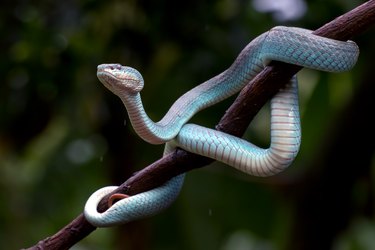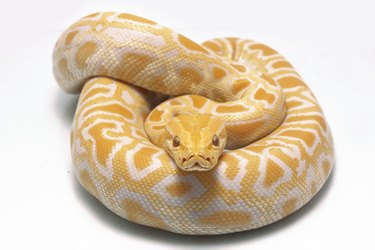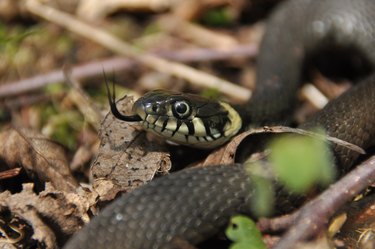
Snakes are fascinating but unfortunately misunderstood creatures. With as much as 5 percent of the population in the United States identifying as being afraid of snakes, these legless reptiles have an unfair reputation of being dangerous and aggressive. However, there are many species of harmless snakes, and some of them are known to make great pets. Learning a bit about snake behavior and body language can go a long way toward easing fears. Understanding why snakes hiss is a great place to start.
Snake personality traits
Video of the Day
Though snakes are commonly seen as aggressive, in reality, they are shy, solitary creatures who prefer to be left alone to go about their business. Snakes see humans as big, scary, and noisy, and any snake you encounter in the wild wants absolutely nothing to do with you — yes, even the venomous ones!
Video of the Day
Snakes do not chase people in order to threaten or attack them. If you've ever heard a story about someone being chased by a snake, it's most likely that the snake was simply trying to get away from the person, and the easiest escape route happened to be in a direction that made the person think they were being chased.
Defense mechanisms of snakes
Snakes have a few defense mechanisms they will employ when they feel threatened. Their first line of defense will always be to flee. Snakes can hear, though not very well, and they mainly rely on their ability to sense vibrations in order to locate danger or prey. If you're an avid hiker and are wondering why you've never seen a snake, it's likely because a snake sunning itself on the trail felt the vibrations of your footsteps and hightailed it into the nearest patch of grass to hide.
If snakes are unable to flee or are cornered or surprised, they may move on to some more intimidating tactics. The nonvenomous hognose snake is known to flatten his head, open his mouth wide, and play dead when threatened, earning the affectionate nickname of "drama noodle." The venomous rattlesnake will rattle his tail to warn potential predators to stay away; contrary to popular belief, they do not rattle to indicate they are getting ready to strike. Hissing is another form of defense that snakes will use as a way to say, "Back off!" Snakes do not hiss as a way to communicate with each other; hissing is purely a defensive display.

How do snakes hiss?
Snakes use a respiratory structure called the glottis, a small opening at the bottom of their mouth, to hiss. The glottis is connected to the windpipe and also to the snake's lung (they only have one that functions). In order to hiss, a snake simply needs to take a breath and exhale. The hissing sound is caused by fast-moving air passing through the glottis.
Though snakes are sometimes seen hissing with their tongue out, their tongue doesn't play a role in creating the noise. Rather, snakes use their sensitive tongue to pick up chemical signals in the surrounding environment. A snake who is sticking out her tongue while hissing is trying to get a better idea of the threat to which she is responding.

What kinds of snakes hiss?
All snakes, venomous or nonvenomous, are capable of hissing, but not every species does it. Some species that are commonly known to hiss include the ball and reticulated python, boa constrictor, hognose, cobra, anaconda, and black mamba. It's not clear what determines why some snakes are more likely to hiss, but it may have something to do with their size or ability to create other defense displays, such as rattling or playing dead.